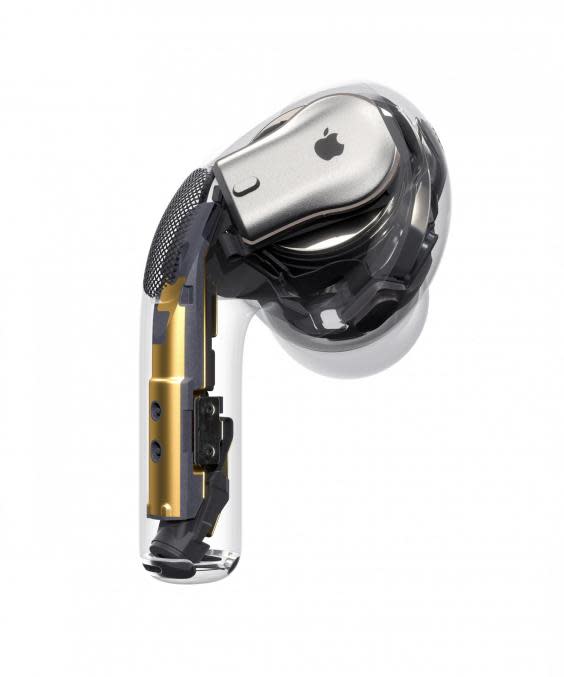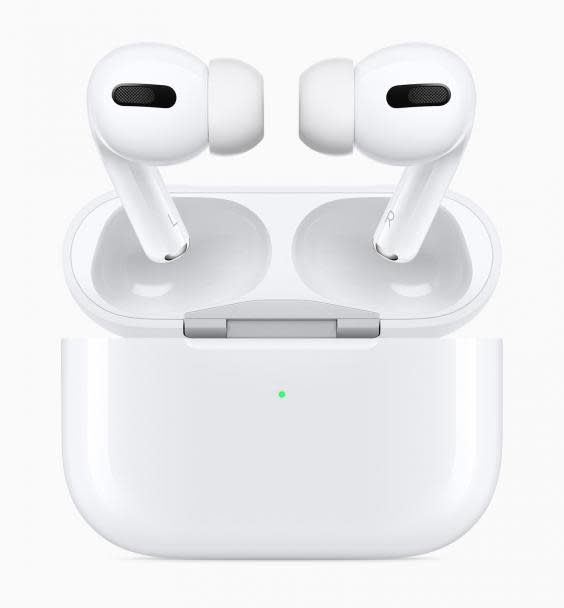Apple AirPods Pro review: 'Jaw-droppingly good' audio combines with fantastic noise cancellation
Apple AirPods have certainly been a success. Within three months of first going on sale in 2016, they’d become the number one wireless headphones in the world. Within a year, they became the number one headphones of any kind.
Hopes are high for the new model.
First of all, they’re not called AirPods 3, just because they’re the third iteration. Just as the iPhone 11 was accompanied by the iPhone 11 Pro, so the new headphones sit alongside the existing second-generation AirPods as the top-end part of the range.
AirPods Pro have a completely new design, though they’re immediately recognisable as AirPods with the same gloss white finish and stem that points down towards your mouth. But that stem is noticeably shorter this time and has a more solid look to it.
The earbud is plumper than before and as a result it sits more securely in the air. Although tales of AirPods falling out of ears were few – simply mislaying the tiny gadget was much more common – the new design feels comfortingly safe.
The new AirPods are also water- and sweat-resistant. That doesn’t mean they can survive being submerged and you definitely shouldn’t swim in them. The Ingress Protection rating is IPX4 which means “Protected against water sprayed from all directions – limited ingress permitted”. In other words, great for working out or suitable for wearing in the rain.
One big new part of the design is the silicone ear tip, meant to be the first way to create strong audio by ensuring there’s a decent seal to keep the outside world out and the music in.
Typically, Apple has included its own way of ensuring the perfect fit. Three sets of silicone ear tips are included in the box. The medium ear tip is in place. Once you’ve put the AirPods Pro into your ears, the Ear Tip Fit Test on the iPhone awaits: music is played and the inward-facing microphone can tell if there’s a decent seal or not.
If it decides there isn’t, the test advises you to adjust the AirPod or try a new ear tip. Apple has devised a clever system that keeps the silicone tips solidly in place while still making them easy to swap.

The tight seal means the audio quality is already better than on previous AirPods but the big new feature on AirPods Pro is also audio-related: active noise cancellation.
I’ve been trying this feature more or less continuously and I might as well tell you now, it’s fantastic.
As with other active noise cancellation features, it works by using a microphone that listens to the world outside and creating a noise which is reversed in phase to cancel out the external noise.
Some other in-ear headphones have this, such as the upcoming Huawei Freebuds 3 and the widely-and-justly applauded Sony WF-1000XM3.
Apple’s noise cancellation is very skilfully done, and highly effective. Turning on noise cancellation in a crowded room is almost like watching a movie dream sequence where the voices of people around you smoothly but swiftly fade away.
In some headphones, noise cancellation can affect the audio quality of the music you’re playing. I haven’t found that to be the case here.
With regular AirPods, and these too, removing one bud from your ear pauses the music, and putting it back starts it up again. It’s the natural way to respond if someone comes to speak to you.
That feature is here, too, but there’s also another way to hear the outside world. It’s called Transparency Mode and it means the music still plays but you can hear your voice and that of the person you’re talking to. In other words, it overcomes the noise-isolating seal to make your voice sound as it would if you weren’t wearing headphones.
Battery life on AirPods Pro is the same as on the previous version, that is five hours. Unless you have either noise-cancellation or Transparency turned on, which reduces the charge to four hours 30 minutes. There’s another 19 hours of charge in the case, again as before.
Oh, and by the way, although this is a Pro model, it doesn’t mean there’s a USB-C connector on the charging case. Like previous AirPods and like the current iPhone 11 Pro, the AirPods Pro use a Lightning connector.
What is different from previous AirPods is the cable that’s supplied - here it’s a Lightning to USB-C cable, not USB-A as previously.
Because of the silicone ear tips, the mechanism for changing tracks used on previous AirPods – a vigorous tap on the AirPod stem – isn’t quite so comfortable.
So, the stem on the AirPod Pro has a flat capacitive touch panel, called a force sensor which, when you press and hold it, switches between Noise-Cancelling and Transparency mode. I found the easiest way to activate this was to squeeze the AirPod stem from both sides.

A shorter touch is used to pause tracks or answer calls, repeated touches change to next or previous songs. It’s a different interaction but easy to get used to.
Although the new AirPods Pro buds are slightly heavier than before, they don’t feel it and the bigger case is still highly pocketable and light.
The audio quality isn’t the only element with AirPods Pro, though it’s obviously the most important. When you pair any pair of wireless headphones with an iPhone, the set-up and usage is important. To pair the AirPods Pro you simply open the case next to your iPhone and it’s done. It makes using AirPods a seamless experience.
AirPods Pro are more expensive than regular AirPods which cost £159, or £199 if you opt for the model with a wireless-chargeable case. So, there’s a £50 premium for AirPods Pro which cost £249. This is a higher price than rival noise-cancelling in-ears from Sony and Huawei.
Is it worth the money? I’d say yes, just for the jaw-droppingly good audio you get with noise-cancelling turned on. Add in the smooth user experience, the excellent, comfortable fit and the cute design, and AirPods Pro become a compelling prospect.
Read more
AirPods Pro will scan your ears to tell you if they fit correctly


